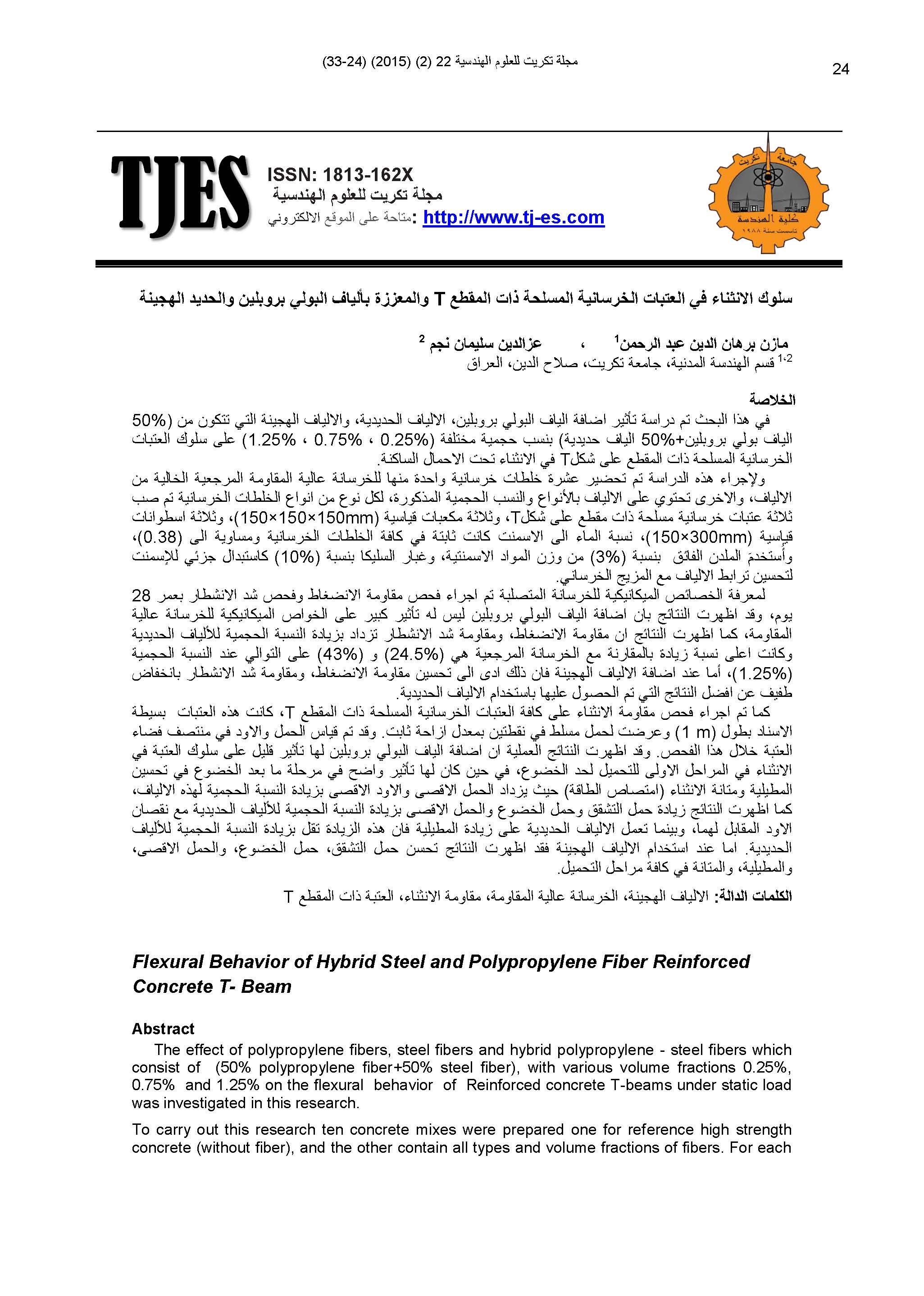Flexural Behavior of Hybrid Steel and Polypropylene Fiber Reinforced Concrete T- Beam
محتوى المقالة الرئيسي
الملخص
The effect of polypropylene fibers, steel fibers and hybrid polypropylene - steel fibers which consist of (50% polypropylene fiber+50% steel fiber), with various volume fractions 0.25%, 0.75% and 1.25% on the flexural behavior of Reinforced concrete T-beams under static load was investigated in this research.
To carry out this research ten concrete mixes were prepared one for reference high strength concrete (without fiber), and the other contain all types and volume fractions of fibers. For eachmix three reinforced concrete T-beams, three cubes (150×150×150mm) and three cylinders (150×300mm) were casted. Water cement ratio was constant 0.38, silica fume with ratio of 10% as a partial replacement by weight of cement and super plasticizer with ratio of 3% by weight of the cementitious material were add to enhance the bond between fiber and cement matrix.
28-day compressive strength and split tensile strength tests were made on hardened concrete specimen. The result showed that polypropylene fiber had little effect on mechanical properties of the high strength concrete. Compressive strength and splitting tensile strength of the steel fiber-reinforced concrete improved with increasing the volume fraction, achieving 24.5%, 43%, respectively, at 1.25% volume fraction. On the other hand, the addition of Hybrid fiber to high strength concrete improved compressive strength and splitting tensile stress with slight decrease as compared with the best improvement.
All of the reinforced concrete T-beams were tested in flexure using controlled displacement two point loads applied on simply supported T-beams, during this test the load and deflection at mid span were measured. The result shows that the addition of polypropylene fiber had a little effect on the behavior of reinforced concrete T-beam at first steps of loading until yielding load, while, it was more effective in improving ductility and toughness (energy absorption) where the ultimate load and max deflection were increased with increasing volume fraction. The addition of steel fiber increased the cracking load, yield load and ultimate load capacity with increasing volume fraction, at the same time reduce deflection. The ductility improved by the addition of steel fiber, but this improvement decreased with increasing the volume fraction. The addition of hybrid fiber improved crack load, yield load, ultimate load, ductility and toughness at all steps of loading.
تفاصيل المقالة
القسم

هذا العمل مرخص بموجب Creative Commons Attribution 4.0 International License.
THIS IS AN OPEN ACCESS ARTICLE UNDER THE CC BY LICENSE http://creativecommons.org/licenses/by/4.0/
المراجع
- Suprenant, B. A., and Malisch, W.R., “The Fiber Factor”, Concrete Construction, Addison, Illinois, pages 43 to 46, October 1999.
- Romualdi, J. P., and Mandel, J. A., “Tensile Strength of Concrete Affected by Uniformly Distributed and Closely Spaced Short Lengths of Wire Reinforcement”, ACI Journal, Proceeding, Vol. 61, No. 6, pp. 657-671, June 1964.
- Song, P.S., and Hwang, S., “Mechanical Properties of High-strength Steel Fiber-Reinforced Concrete ”, Construction and Building Materials, Volume 18, Issue 9, pp. 669-673, November 2004.
- Bei-xing, L., Ming-xian, C., Fang, C and ping, L., “The Mechanical Properties of Polypropylene Fiber Reinforced Concrete”, Journal of Wuhan University of Technology, Vol. 19, No. 3, September 2004.
- Yao, Li, W., and Wu, K., “Mechanical Properties of Hybrid Fiber-Reinforced Concrete at Low Fiber VolumeFraction”, Cement and Concrete Research, No. 33, pp. 27-30, 2003.
- Abdul-Ahad, R.B., and Aziz, O.Q., “Flexural Strength of Reinforced Concrete T-Beams with Steel Fibers”, Building and Construction Department, University of Technology, Iraq, Cement and Concrete Composites, Volume 21, Issue 4, pp. 263-268, August 1999.
-7 المواصفة القياسية العراقية رقم ) 5(، "الاسمنت
البورتلاندي"، الجهاز المركزي للتقييس والسيطرة
النوعية، المواصفة القياسية العراقية، بغداد، 1984 .
-8 المواصفة القياسية العراقية رقم ) 45 (، "ركام
المصادر الطبيعية المستعمل في الخرسانة والبناء"
،الجهاز المركزي للتقييس والسيطرة النوعية، بغداد،
.
- ASTM C 33-01, “Standard Specification for Concrete Aggregates”.
- ASTM C1116-97, “Standard Specification for Fiber-Reinforced Concrete and Shot Crete”.
- Khader A., “Evaluation of the Constructability & Performance of Micro-Silica Modified Concrete Bridge Deck Overlays”, Wisconsin Department of Transportation, Report No.10, December 2003.
- ASTM C1240-03, “Standard Specification for Use of Silica Fume as a Mineral Admixture in Hydraulic-Cement Concrete, Mortar, and Grout”.
- ACI Committee 211, “Guide for Selecting Proportions For High- Strength Concrete Using Portland Cement and Other Cementations Materials” ACI 211.4R-08,American Concrete Institute, 2008.
-14 هناء عبد يوسف، "فحوصات في تكنلوجيا
الخرسانة"، الجامعة التكنلوجية، صفحة 67 ، 1990 .
- BS 1881, Part 116, “Method for Determination of Compressive Strength of Concrete Cubes”, British Standards Institution, PP. 3, 1989.
- ASTM C 496 – 96, “Standard Test Method for Splitting Tensile Strength of Cylindrical Concrete Specimens”.





